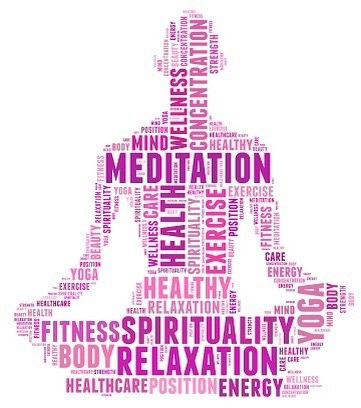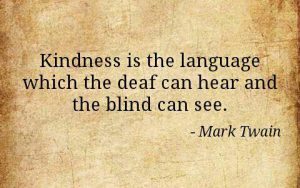Rajiv Parti's Blog
October 26, 2016
Practicing Stress Management
Chronic stress has been called the ailment of our time. Chronic stress is much different than acute stress. Acute stress is our natural reaction to danger. Like other mammals, we have evolved to be constantly on guard for possible external threats. When we perceive a threat, our body reacts immediately. This is called the stress response.
For example, suppose you’re hiking in the woods and see a bear on the trail in front of you. Your body immediately responds by pumping a host of hormones into your blood. These hormones cause a number of physiological reactions. Your heart rate, blood pressure, and breathing rate increase. Your cells pump out extra energy. Your sensory acuity increases. Other physiological changes take place. This stress response to a perceived threat is natural. It helps you prepare for a dangerous situation very quickly. Once the danger has passed—once the bear sees that you’re wearing a Batman T-shirt and runs away—your body returns to its normal state.
Chronic stress is different. Chronic stress can develop from continually worrying about finances, relationships, health, or countless other life issues. In today’s world, we may feel stress from when we rise in the morning until we lay our heads down at night.
It starts in the morning with finding you’re out of your favorite cereal. Then you get stuck in traffic, and arrive late to work to find the network down. All day, phone calls interrupt your work and you have to stay late to finish. You get stuck in traffic again and arrive at 8:30, dinner cold and kids irritable. Having felt stress throughout the day, you just want to go to bed.
The Toll of Chronic Stress
The problem with chronic stress is that the stress response occurs again and again, sometimes without letup. Your body doesn’t return to its normal state. The extra hormones—such as cortisol, catecholamines, and vasopressin—continue circulating in your blood, gradually doing damage.
The excess cortisol suppresses the immune system, which is so crucial to fighting off bodily threats such as dangerous bacteria and cancer.
Both cortisol and catecholamines contribute to type 2 diabetes by elevating blood glucose levels.
Catecholamines and vasopressin increase blood pressure, which increases the risk of cardiovascular disease.
In addition to overproducing stress hormones, psychological stress increases the activation of blood platelets, which play an important role in the evolution of atherosclerotic plaques and the arterial clotting that leads to myocardial infarctions and strokes. Research also shows that chronic stress increases the risk of asthma, gastrointestinal dis- orders, cardiovascular disease, and even cancer.
In a word, over time, chronic stress can be a killer.
Chronic stress also takes a large toll in the other three dimensions of our lives. It decreases our enjoyment of life. It interferes with our problem-solving abilities. It can impair our social relationships and detract from the spiritual dimension of our lives. Its prevalence in today’s society and the damage it does to our lives is why Practice Stress Management is a Law of Wellness. In today’s world, it is crucial to learn strategies for deal- ing successfully with chronic stress so we can stay calm in stormy seas.
Two Strategies for Managing Chronic Stress
There are two basic ways to manage stress. The first is to change the situation that causes the stress—the stressor. For example, if your job constantly drives you up the wall, one solution would be to find a less stressful job. Or if you’re anxious about the possibility of having a heart attack, you could work with your physician on a get-healthy plan to re- duce that possibility. Or course, as a doctor myself, I highly recommend this general strategy for any health issues that may concern you.
Sometimes, though, it’s not easy to change the stressor. What you can change is your reaction to stressors. There are two main ways to do this. One is to reframe the stressor. This technique rests on the idea that something is a stressor only in a perceived context. For example, being in a traffic jam is not itself a reason to become upset. But if you perceive that being stuck in traffic will make you late for a meeting, which might harm your prospects for promotion, your hormones may start pouring out. You can defuse this reaction by changing your perception of your situation. For example, you can realize it makes no sense to stress out about something you can’t control. The continuing stress re- action only jumbles your thoughts. But if you calm down, you can start thinking productively about how to counteract any negative results of being caught in the traffic.
A second way to change how you react to stressors is to find activities that promote calmness and resilience. Meditation can be an effective calming practice. You don’t have to be religious to meditate. Meditation can simply be a way to calm your mind and body. When you complete the meditation, you are more relaxed and better able to deal with situations without getting stressed-out. This is the relaxation response that Doctor Herbert Benson of Massachusetts General Hospital has studied and written about for many years. The relaxation response reverses the stress response by normalizing the body’s physiology.
Meditation is easy to learn. Daily meditation for 15 to 30 minutes in the morning can be a wonderful investment by helping you reduce stressful feelings throughout the day. Other stress-reducing practices include:
mini-meditations that take only a minute or two,
mindfulness meditation can be done while you’re walking, vacuuming the floor, or just about time when it won’t conflict with other activities, like driving.
Tai Chi, which involves graceful motion and is also a kind of meditation.
Yoga, which has a calming effect on the mind while increasing your physical dexterity and resilience and refreshing you mentally and spiritually.
There are also important non-meditation strategies that you can use to counteract stress. These include:
good old-fashioned exercise,
going for a walk in a park or somewhere out in nature,
taking up a relaxing hobby such as woodworking or coin collecting.
You can find information on how to go about various meditative techniques on my website at www.rajivparti.com.
October 14, 2016
8 Steps to Ayurvedic Treatment for Addiction – Part 2
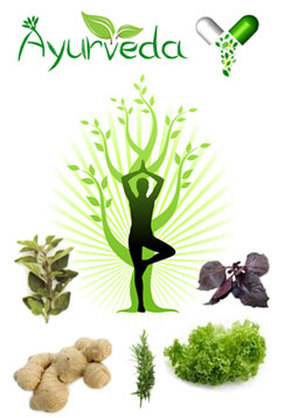
You will find part 1 here – Ayurvedic Treatment for Healing and Addiction – Part 1
5. STEP FIVE: Healing and Revitalization – Prana
Prana is the vital energy brought to us through oxygenation and breath. It’s a known fact that where there is stress, breath is shallower and therefore oxygenation is limited. Where breathing is not happening optimally, oxygenation is limited and there is impaired cellular regeneration and mental functioning.
Learning how to breath, and how to move Prana – vital energy – around the body, especially to those parts that feel wounded or disturbed is a huge component of Ayurvedic care called Pranayama. There are several Pranayama exercises and practices – from Ujjain breath, Kapalabhatti and others.
Yoga is more than physical exercise: yoga is the art of moving Prana – vital life energy – through the body for healing. Yoga therefore becomes another essential instrument for healing in the Ayurvedic approach to addiction recovery.
What You Can Do At Home:
1. Learn about Pranayama and breathing exercises by enrolling at your local yoga studio or go online at www.anmolmehta.com to see a number of videos on different Pranayama exercises you can do at home.
6. STEP SIX Yoga – Replacing Old Bad Habits With New Good Habits
Yoga is the sister science of Ayurveda. It works in addiction because in yoga the body and the mind are simultaneously calmed, with the intentions of practicing acceptance and of changing unhealthy habits. The practice calms the nervous system, the endocrine system and activates the release of healing hormones in the body as well as stimulating the brain to produce alpha waves –which are known to support visualization without emotion: in this state we can see ourselves performing past actions without feeling the emotions attached. Over time this judgement free practice allows us to view images of the past neutrally, and dissolves triggers that may have stimulated an individual turning to a drug of choice.
What You Can Do At Home:
1. Learn about yoga by enrolling at your local yoga studio or go online at Free Online Yoga Classes to join beginner and advanced yoga classes you can do at home for free.
7. STEP 7 Yoga Nidra – Setting New Intentions
Yoga Nidra is a guided meditation that has properties that are uniquely helpful in treating addiction. Yoga Nidra is the practice of lying still on one’s back, with one’s eyes closed whilst following the instructions of a meditation teacher. The practice involves the gradual shutting down of all the body’s sensory channels except hearing, until ultimately the patient is brought to the state of consciousness we usually experience only in sleep – without being asleep. In this state, the body automatically activates rest and repair that is usually saved for sleep, whilst the patient is directed to envision a specific sequence of images with the desired effected that the mind is cleansed all negative subconscious associations usually processed only in dreams; finally, in a state of deep relaxation, usually associated only with sleep, the patient sets new intentions for their life. This process of unconscious cleansing and intentional suggestion in a state of deep rest, relaxation has powerful and lasting effects on reconditioning the addicted person’s mind in their every day functioning. Play today at the best kizi games.
What You Can Do At Home:
1. Learn about Yoga Nidra at www.irest.us or visit http://video.google.com/videoplay?docid=6097261061531748663 to listen to master Yogi, Manoj guide you through a Yoga Nidra exercise.
8. STEP 8: Meditation: An Every Day Medicine
Meditation as a practice has been shown to strengthen the pre frontal cortex in the brain – the part of the brain responsible for executive decision making and higher cognitive capacities. It has also been shown to relieve the stress networks of the brain (that activate stress) and to strengthen the GABA reward pathway of the brain.
In addiction, the brain needs all this work: the executive function and decision making faculties are impaired, the stress network is hyperactive, and the reward pathways have been distorted by the drug of choice.
If there’s one medicine that anyone facing addiction can take immediately at no cost: it’s meditation
Practicing meditation daily whilst simultaneously undergoing the kind of Ayurvedic treatment described in the previous six steps is absolutely going to offer daily insight, clarity and awareness – on what the root cause of the stress is; on what is driving a person with addiction to their drug of choice; on what the costs of their addiction are to them and their loved ones; on what they need to do to stop their negative behavior.
This is all essential insight. When it emerges as a patient is undergoing a treatment program as complex and as multisensory as the Ayurvedic treatment for addiction, this information can be integrated in the processes of detoxification, purification, creating new habits and setting new intentions.
Meditation will continue to play a daily critical role in life beyond treatment: knowing early on when stressors are (re) emerging is a key component to staying addiction free. A daily meditation practice delivers this. Mandalas, Mantra and mindfulness techniques concentrate the mind, and create a level of awareness that can direct our behavior: knowing when to step back from things that we know will hurt us and our loved ones; knowing when we want to step forward and celebrate relationships and situations that nurture our wellness.
What You Can Do At Home:
Inquire for a meditation class with TM in your area at www.tm.org or else look up a Chopra Center Priomordial Sound Meditation Instructor in your local area at http://www.chopra.com
October 7, 2016
8 Step Ayurvedic Treatment for Addiction and More – Part 1
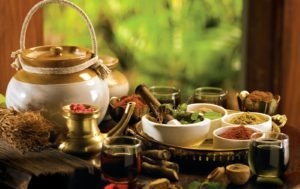
Ayurveda’s treatment for addiction recovery is a process: a lifestyle and a journey into wellness. It is an invitation to participate in our own wellness and healing, to co-create our full potential and to live every future day with a commitment to nurturing and valuing ourselves.
Ayurveda is a whole person non-invasive, non-pharmaceutical approach aimed at perfect balance – not a method in which we become pharmaceutically dependent patients. It teaches that all material forms in the entire Universe – including the human being – are made up of different combinations of five essential elements, the Mahabhutas. These Mahabhutas are: Space, Air, Fire, Water, and Earth.
Differing combinations of these essential elements create an infinity of material forms: differentiating a flower from a river, a mountain from a cloud, a human being from a star; But every material thing contains a combination of these elements – the cosmos and we are made of the same materials.
Ayurveda teaches that in human beings there are three dominant combinations of these elements that give us each our specific body mind constitutions: these three constitutions are called ‘doshas’, each one of the representing a vital dose of the essential elements in our own individual make up: Vata (the Air element), Pitta (the Fire element) and Kapha (the Earth element):
1. STEP ONE: Identifying the Doshas
Typically each one of us will have a dominant dosha that determines our over riding body mind constitution. We can be categorized as a planet of Vata types, Pitta types or Khapha types – and our inclinations, capacities and nature will be determined by our dosha.
Vata types tend to be highly creative, quick thinking, quick to learn and forget, lean, physically and mentally agile, involved in many things at one time, and prone to anxiety and overwhelm.
Pitta types tend to be leaders, extremely focused, goal oriented, driven physically and mentally and prone to bouts of anger, possible aggression, frustration and impatience.
Kapha types tend to placid, easy going, slower and heavier physically and prone to being anxious to avoid conflict, and experiencing mental and physical inertia or fatigue.
When the doshas are in perfect balance, we humans are well, functioning optimally, mentally and physically, living with vitality and in ease. When the doshas are disturbed, our wellbeing is obstructed, our mental and physical functioning is impaired, and we will live with fatigue and dis-ease.
At the heart of all Ayurvedic treatments therefore is the intention to restore balance to the doshas. Once this is achieved, wellness flows naturally.
Having diagnosed the individual’s dosha type and which doshas are experiencing stress, treatment will now focus on the removal of the stress.
For this the therapeutic practices of Ayurveda center on creating restfulness, restoring calmness, nurturing the body-mind. The mind, and the subtle energy of the body-mind are all equal targets for therapeutic applications.
What you can do at home:
1. Find out your Dosha at http://doshaquiz.chopra.com/
Creating a stress free zone to allow the doshas to come in to natural balance, and support the individual’s natural intelligence at the physical, emotional and mental levels to re-emerge then becomes the foundation for all further treatments.
2. STEP 2 : Rebuilding the Body: Re-storing – Ojas
The Ayurvedic texts identify a substance called ‘Ojas’ as being the vital force of the body. Like honey is the essence of flowers, in the same way, Ojas is considered to be a secreted essence from our tissues, muscles, blood, plasma, fats and bones: produced by all healthy cells, imparting strength, radiance, luster, and power to the body and mind.
In addiction, this Ojas is being continually depleted – and ultimately the depletion of Ojas will eventually cause death. One of the main areas of focus therefore is restore Ojas in the body.
Ojas is mainly cultivated through diet – the useful product of food materials.
Therefore in Ayurveda, there is a major emphasis on diet.
Treatment should center around foods that support the restoration of Ojas, and also support sup: green vegetables, kale, parsley, spinach, rice, honey, almonds, strawberries, mangos, split mung lentils, amaranth, cooked lightly in spices that are also Ojas enhancing: cumin, coriander, ginger, fennel, cinnamon.
What can you do at home:
1. Cut out foods that are processed or pre-cooked
2. Stock up on lots and lots of green leafy vegetables
3. Try cooking with fresh spices: fennel or cinnamon or ginger
3. STEP 3: Restoring Natural Intelligence : Cultivating Tejas
Vitality in Ayurveda is not something that occurs only in the body. Tejas is the radiant vitality of the body-mind’s innate intelligence: the intelligence by which our cells innately perform a myriad of miracles – carrying oxygen molecules in our blood or releasing neurotransmitters or metabolizing nutrients from foods and identifying waste materials – simultaneously, continuously. Tejas is also the means by with which we can digest and process mental thoughts and impressions, and experience higher perceptual capacities;
Having strong Tejas therefore gives us digestive and information processing power at the mental and physical levels: cellular metabolic energy.
Restoring Tejas would involve calming the nervous system, through a variety of techniques that involve Panchakarma (a series of detoxification and purification therapies) and ‘Rasayana’ – the practice of destroying disease through the conservation transformation and revitalization of energy.
(see step 4)
4. STEP FOUR: Detoxification and Purification: Panchakarma
Pancha means ‘five’ in Sanskrit and ‘karma’ means action.
Panchakarma is a unique set of five detoxifying Ayurvedic treatments administered in three phases: the preparation, cleansing, and rejuvenation phases.
The first phase is oleation – ingesting and applying pure essential oils in order to mobilize the accumulated toxins in the body. The first of the five actions of Panchakarma here is ‘Swedana’ – the application of hot steam and warm oil therapies that loosen toxins and encourage their flow to the GI tract for elimination.
The second phase is the cleansing phase: now that toxins have been mobilized, their elimination is focused upon through a further three actions, all of which are administered gently through the application of medicinal herbal oils: Basti (intestinal irrigation); Nasya(nasal irrigation) and Vamana (oral elimination)
The final phase of Panchakarma is Rasayana: here medicinal and Ayurvedic oils are applied in uniquely restorative bodywork and massage techniques. Most famous of these is the practice of ‘Shirodhana’ – where warm oil is poured continuously on to the center of the forehead between the two eyes: acting as a powerful pacificier for the entire nervous system.
Further Rasayana would be pursued through Ayurvedic herb prescriptions using the healing properties of plants and flowers, for example:
Ashwaghandha – proven in some 216 medical to: confer immune system protection, combat the effects of stress, improve learning, memory, and reaction time, reduce anxiety and depression without causing drowsiness, reduce brain-cell degeneration.
Guggulu – purifying herbs. It cleanses unhealthy tissues, increases the white blood cell count and rejuvenates the
Brahmi – nerve tonic
Ayurvedic teas and tonics would be included in the diet every day to enhance healing, reduce stress for the rebuilding of tissues: pumpkin is a known sedative, nutmeg is a nervine, and chamomile is a digestive tonic and known sedative nervine herb.
What You Can Do At Home:
1. You can order many of these herbs and teas are available at reputable herbalists, and my own favorite source for these is at world center of excellence, with whom I have personally trained, The Chopra Center: http://store.chopra.com/showitems.asp?deptcode1=717
Stay tuned for part 2 of Ayurvedic Treatment for Addiction and More, where Dr. Raj will detail steps 5 through 8…
September 30, 2016
The Seven Eternal Truths

My near death experience taught me about my mission in life, which is to help people heal there pain and trauma through consciousness based healing and find a path to joy and celebration. This requires healing diseases of soul- pain, depression and addictions. The medicine prescribed for this healing consists of compassion, loving-kindness, gratitude, forgiveness, and living in service.
The other important gift of my Near Death Experience was a lesson on the Seven Eternal Truths.
The Seven Eternal Truths are as follows:
Consciousness exists outside of the body.
There is life after death.
We have past lives and our experiences therein can shape our current realities.
We are all connected to each other because we are all made of the one and same energy that manifests as differentiated matter.
Divine beings exist to help and guide us.
There are different levels of consciousness.
There is one, all-pervading, supreme love and intelligence that is the source of the entire universe, and that love is the supreme source of creation.
What do these truths mean to you, and how have they appeared in your life? I encourage you to leave your response in the comment section below or to join my Near Death Experience discussion group to share your thoughts and experiences here at www.dyingtowakeuphealing.com
September 20, 2016
Light Being Meditation
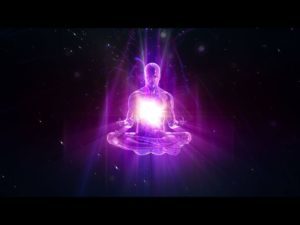
The purpose of this meditation is to give an experience of Bliss (Nirvana), to have a Near Death-like experience without having an NDE, and to connect with your Guides/Angels and to bring their blessings/messages back with you. This way of connecting/witnessing the “Light Being” can help you in the here and now of your life.
Sit comfortably on floor or in the chair. Lying down is fine too but remember, we are trying to enhance comfort, not go to sleep.
Once you are comfortable, close your eyes and take a deep cleansing breath Hold for count of 3 and let go. Then breathe regularly. With each “in” breath you are inhaling peace love and joy and with each “out” breath you are releasing tension, stress and mental toxins.
With each breath you should become more relaxed by focusing on your muscles and relaxing them, including those of jaw and tongue.
I will count backwards form 5 , and with each count allow your relaxation to go deeper and deeper.
Imagine there is a silver cord anchored deep within the earth and connected to your body and soul. From this room you find yourself inside a tunnel. You can see beautiful white light at end of the tunnel. Float toward the lighted end.
Beyond the Light are your guardian angels, spirit guides, ascended masters or your higher self greets you. Expect to see them but don’t be disappointed if you don’t see them your first time or every time you perform this meditation. If you see them or not, they may have a message for you. Open yourself to receiving a message by clearing you mind of chatter. If tThese celestial beings appear they will most likely guide you toward a beautiful meadows filled with flowers of vibrant colors. There may be crystal clear streams flowing from the lush green mountains and a subtle sweet, soothing aroma to the gentle breeze. The sound “OM” may permeate from all around you like a divine hum.
You will move toward a bright Light, possibly accompanied by celestial beings. The Light may be brighter than the sun, but painless to the eyes. You become aware of the presence of a Being who brings you a feeling of utmost joy, bliss, and love, These feelings may be the most pleasant you have ever felt, feelings that are soaked with Divine Love. Accept them with all of your senses as if you can see love, hear love, touch love and smell love. This is bliss. Accept this wonderful gift and thank the Light Being.
I will be quite for next 10 minutes and let a gentle “OM” keep you in this state of Nirvana.
Gradually become aware of your surroundings. Wiggle your toes and fingers and sense this room and surroundings. And when you are ready open your eyes. You may be bringing back message as well as feelings of supreme peace, love and joy.
Immediately record all you have witnessed, either in writing or with a voice recorder. Doing this will remind you of your journey to the spirit world.
September 13, 2016
Electronic Silence

My son was about to leave for medical school in Aruba and passed an exam with flying colors, so we went out for an elegant celebratory dinner. When we reached the restaurant, I realized I left my iPhone at home. I was flabbergasted. I couldn’t recall anytime in past when this had happened, and when it had, I would have immediately turned around to get it. The iPhone had become an extension of my body, but that dinner I decided to try living without it.
I was the kind of guy who was checking email, Facebook and Twitter every minute. Every email had to be answered right away. I felt the need to remain connected to the electronic world at all times. I even felt myself having “withdrawals” on flights. As soon as the plane would touch down, I had to turn it on.
I would not hesitate to call myself an “IPhone Junkie”, but that dinner without my iPhone was one of the most memorable ones in my life. My son and I had the best time, laughing, talking and bonding more like old friends, instead of father and son.
Since that day, I often practice what I call “Electronic Silence”. For two hours, I don’t check my email and social media. For real emergencies, I still have my home number, but funny how it almost never rings.
This two hours of “Electronic Silence” brings much peace to my life. It is a meditation in itself, and has immensely reduced my stress level. Now, I turn iPhone off during the three basic moments I enjoy the most: dinner, quality time with my wife, and during Meditation.
Now, I even turn the TV off during dinner. In this fast world, it’s often the only time to interact as a family, to bond together in uninterrupted time.
These days, I see “IPhone “Junkies” everywhere, crossing a busy street while texting, texting while driving… These activities not only endanger just the person, but others too. Similarly, I see people doing the same with friends and family at dinner in restaurants.
I urge everyone to connect with live people by talking and looking in the eyes, instead of talking while staring down at a phone.
So my friends try practicing this “Electronic Silence” it will give you your self-back, make family bonds of love stronger and reduce the stress level.
True silence is the language of the spirit, and I hope you can make electronic silence a daily practice. It will transform your life.
September 6, 2016
Why Meditate?

Meditation is an ancient state of “Being” well known to Eastern spiritual traditions, both Hinduism and Buddhism, but it has also been practiced in various forms in Western spiritual traditions too. In modern medical-physiological terms, it is defined as one of the four states of existence. The other three are wakefulness, sleep, and dreaming.
One beauty of meditation is that a person does not have to be religious or spiritual to get advantages from its practice. These benefits can be divided into physical, mental, and spiritual.
Physical benefits
The physical benefits of meditation have been known since ancient times. But they have become better known in the West since the 1960s when meditation as practiced now was brought to the West by spiritual leaders such as Maharishi Mahesh Yogi of Transcendental Meditation fame. In addition, research by various Western universities using lab studies and modern-day instruments such as the EEG (electroencephalogram) and brain scanning equipment have helped bring these benefits to light.
Multiple physiological benefits have been discovered. The meditative state has been found to elicit the “relaxation response,” a term first coined by Herbert Benson, MD, of Harvard Medical School, and also known as the “rest and repair” state. The relaxation response is the opposite of the “fight or flight response,” which is a necessary reaction found in both humans and lower animals when faced with danger.
In the fight or flight response, the sympathetic nervous system goes into overdrive to help the organ-ism survive the danger. The response consists of various physiological changes that take place through the activities of neurotransmitters and the emission of certain hormones. As a result, heart rate, blood pressure, and glucose consumption increase, and a heightened mental state occurs as the animal prepares, in the face of the danger, to fight or to take flight.
Though the fight or flight response is common to both animals and humans, there are important dif-ferences. For one thing, after danger passes, the animal goes back to normal baseline. For example, as often seen on television, a gazelle when faced with a lion goes into this hyper state and runs for its life. But a few minutes later, when the danger has passed, one sees the gazelle grazing calmly as if a few minutes before there had been no danger at all.
In contrast to the gazelle’s behavior, when we humans enter the hyper state, we may continue to live in that state for long periods. This is largely because humans often perceive a much wider range of possible “dangers” than animals do, and these perceptions continue for long periods of time. For example, humans may enter the hyper state simply from perceiving threats in areas such as relationships, finances, work, personal efficacy, and future success. Faced with such concerns, we may feel threatened virtually all the time. This can result in chronic stress and various stress-related physical ailments such as heart disease, stroke, and diabetes. These ailments are partly the effects of abnormally stress-heightened levels of hormones such as epinephrine, cortisol, and ACTH.
A major physiological benefit of the regular practice of meditation is that it helps bring hormone lev-els back to their baseline and thereby helps to heal some of our modern day stress-related ailments.
Mental benefits
Chronic stress can also have adverse psychological effects, including depression. In addition, various addictions may arise. To compensate for continual stress, the individual may seek relief through mind-altering chemicals such as alcohol, narcotics, or other drugs.
Meditation has been shown to have a calming effect on so-called hyperactive patients. The effects of meditation on the brain can be measured in modern laboratories. Under the influence of meditation, the hyperactive brain calms down, as is shown by reduced red areas on PET scans. On the EEG, the so-called brain cardiogram, ² (beta) waves that represent the hyper state are replaced with slow ´ (delta) waves.
The regular practice of meditation has become a part of modern addiction programs. By counteract-ing the effects of stress, there is less need for the individual to seek out chemicals to alleviate the stress.
The rest and repair state brought about by meditation helps calm the mind and emotions and often instills a sense of serenity in the practitioner. Meditation helps heal psychological trauma, be it from childhood, post-traumatic stress syndrome, or other sources. It does this partly by helping put events, issues, and concerns into perspective, and by substituting a freer-flow style of thinking for the more analytic thinking that may accompany and stir up anxieties.
Spiritual Benefits
Meditation as a spiritual path has been practiced since ancient times. Often, repetition of various mantras (representing various aspects of God) is done as a form of common meditation.
Meditation in the spiritual sense can be viewed as a means for communing with a higher reality, whether that is called God, our True Self, or the all-pervading Prana or in Hawaiian Mana. In this way, it is seen as a method to help the practitioner grow from the outside-in, leading to more contentment with and gratitude for life.
Meditation as a path to God has been known by various names in Eastern culture, including Dhyan Yoga and Janan Yoga. The term “yoga” in this original sense means union with our True Nature, God, and thus means much more than practicing various stretching exercises and postures.
Meditation can be seen as taking us to the so-called Gap State as defined by the writer Wayne Dyer. It takes us to the gap between our thoughts, where there is nothing. It thereby connects us to the universal “Black Hole” from which, according to some, the whole universe has come into existence. According to some Eastern traditions, this nothingness is the Formless that gives rise to the forms that constitute the reality that we perceive through our senses.
Meditation as a spiritual exercise can also be viewed as helping us connect with a supreme all-pervasive intelligence, a divine creative consciousness. This connection might then lead to a “breakthrough” experience in which the Divine manifests itself through a new wonderful piece of music, art, writing, or some other achievement.
In conclusion, the benefits of meditation are numerous. We all should make a regular effort to meditate. It is a state to be experienced, not just read about. Reading many books on swimming is of little benefit until one experiences it by going into the water. Much the same can be said about meditation.
In the end, one does not even need to know how it works, but it does work. Let’s all experience it for ourselves.
To respond to this blog and engage with the DYING to WAKE UP/HEALING Community, please click here.
July 5, 2016
‘Thoughts On Seva – Service’
Nowadays, the Indian Sanskrit words “karma,” “mantra,” “pundit,” “dosha,” and “chakra” are becoming very mainstream. There is one such word, however, that is not as well known—but needs to be. The word is “seva,” which in Sanskrit means “service.”
Seva is not just any kind of service, but rather selfless service performed with a sense of gratitude. It is service infused with kindness and respect for the ones served, and it arises from a place of peace and love.
If we all were to do our work and carry out our other relationships in accordance with seva, the world would change profoundly. Seva is not about taking a few hours out of our busy week to help others. It’s not something to be turned on and off, as if kindness, compassion, and gratitude are qualities to be doled out in limited amounts. Seva is about designing our lives in such a way that we consistently serve others selflessly. Every action, every interaction should beseva.
This includes in our work lives. Professionals of every stripe—lawyers, doctors, dentists, and others—often assume a distant or even superior attitude toward their clients or patients. They fail to connect with the other person’s humanity. For caregivers to take such an attitude is especially sad because for such professions, the rewards of seva are great. If a doctor, for example, greets a patient with an attitude of compassionate service, with actions and words that essentially say, “I am thankful to you for finding me worthy of service to you, and for providing the means of my livelihood,” then the doctor will likely find that the patient already feels better before anything else is done or said.
Seva is not selective. It does not evaluate our fellow beings and select some for care and respect while ignoring others. It treats all humans with compassion and tenderness.
As The Wisdom of the Tao fifth verse says, “I work at eliminating all of my judgment of others.”
Taking up an attitude of service with gratitude provides us with many rewards in all four dimensions of our lives: physiological, mental, social, and spiritual.
In regard to our physical health, seva is a form of positivity, which Professor Barbara Frederickson of the University of North Carolina reports is linked to a number of physiological benefits. These include a decrease in stress hormones, lowered blood pressure, and improved immune system functioning. Practicing selfless service with gratitude also increases our levels of the feel-good hormones prolactin and DHEA.
Socially, when we let seva guide our interactions with others, we create open spaces where people feel acknowledged, respected, and cared for, as their barriers come down. To practice seva is to recognize the natural bond between ourselves and others. Kindness and compassion take us out of our selfish egos and expand us, making us larger. We strengthen our relationships and friendships, while creating new ones. Socially, everyone benefits from seva.
Mentally and spiritually, seva promotes powerful happiness-creating emotions—kindness, caring, and gratitude. This not only brings profound karmic benefits, it infuses our lives with meaning and value, lifting us up spiritually along with those we serve.
By profoundly affecting all four of our dimensions, seva builds health, peace, harmony, and joy in our lives.
We can even take seva into the bedroom with us. Sex without seva is just sex. But when this basic natural act is approached as seva, it becomes lovemaking. With seva, you do not simply aim for your own personal satisfaction. Instead, you focus on pleasing your partner, giving all you can to making her or him happy. Your partner’s response to this selfless attitude then creates delight for both of you. What results is a wonderful mix of physicality, psychology, and spirituality that leads to ecstasy and deepens intimacy.
My friends, I urge you to undertake all of your activities, personal and professional, in the spirit of seva. To do so is to live by your heart. Without striving, without effort, you will receive many priceless rewards.
Remember the seventh verse from The Wisdom of the Tao:
“It is through selfless action that I experience my own fulfillment.”
June 24, 2016
The Joy of Random Giving
I recently met a a very kind man, Dr Chuck Wall, a retired professor and our local motivational speaker. He has been on Oprah and invited by Presidents to the White House on several occasions. Out of his kindness, he is helping me improve my public speaking skills for free. He is blind but is living a full life. I have a great time with him – we go walking, we go for lunches, we spend many valuable and enjoyable hours together in which I always learn something.
His main motto in life, which I see him live by, seems to be: ‘Do one random act of kindness, every day’ I have modified his to make a motto of my own: ‘Do one random act of giving, be it money, or time, or goods – every day’. Since I started this, it has brought me tremendous joy and inner peace and the best part is that: the more I give, the more everything shows up – the teachers, circumstances, even money! It’s as if there’s an intelligent Universe that seems to say ‘Keep it up, my son!”
Buy beyond the seemingly random good fortune one receives when one gives, there are known medical benefits of giving that have been studied: it can, in fact, make a person heal faster for it increases the good hormones like DHEA, Prolactine, and others – and brings down the catabolic (breakdown) hormones like cortisol and epeinephrine. Let me tell you, my friends – believe it or not – giving is the best anti-aging therapy and anti-depressant there is!
I am sharing this not for my ego, but so that somebody else can also experience the “Joy of Random Giving”. The wise Indian sage, Ramakrishna said that when one donates with the right hand, the left hand should not know of it or how much – let there be no attachment or intellectualization or vanity derived from the act of giving. Simply give. And be done. So I had doubts to write or not this blog. But it is the joy I get of sharing this experience of giving, is the reason I am writing my experiences – perhaps someone reading this will also be motivated to give.
Going back to the medically associated benefits of giving – it has been shown as ‘Teleomeres’ length in people who give and who live with an attitude of gratitude – their lifespan is much longer then otherwise.
Lao Tuz said, “By serving you, I serve myself.”
A great saint of India Ramakrishna said, “We serve Shiva(god) by serving Jiva (individual soul).”
Deepak Chorpa also talks about it in his now famous “The Seven Spiritual Laws of Success” when he refers to ‘The Law of Giving’. This law could also be called the Law of Giving and Receiving, because the universe operates through dynamic exchange. The flow of life is nothing other than the harmonious interaction of all the elements and forces that structure the field of existence.
Let me share with you a list of the last six days of random giving – perhaps you will want to experiment on your own:
I was crossing a street in Santa Monica. The person next me was carrying a can and a collection bag. He did not ask for anything but I gave him $10. He was surprised but very thankful and I was equally joyful with his surprised expression.
At the Starbucks drive-through, I paid for the person behind me too. Just imagining what the reaction of that person would be brought great joy to me. Who was he? Did I know him ? And yet I was able to connect with him!
In a grocery line, a man ahead was looking for change in his pockets and was short of money, so much so that he was going to return an item. I told the cashier to just put it on my bill/check. He was very thankful – and so was I very thankful to have been able to support this man.
Today, I found myself very upset at my assistant; my old self would have fired her, but then a thought came me, why not choose to make this my “random act of giving” for today? And all anger disappeared and I felt at peace and relaxed. My stress disappeared as if by magic. I felt gratitude and appreciation for the hard work she does otherwise.
Yesterday I consulted a spiritual mentor and she asked me for $30 for her time but I actually gave her $50. This is what she wrote back: “All is well – in Guru’s grace.”
I recently blogged about seeing the Divine Mother in every woman, from a CEO to a sex worker:
After seeing my friends dedication, on my own I decided to donate $500 to her to help teach yoga to sex workers. This is what she wrote back:
“Thank you so much for your generous offer of donation for courage to rise. I was just needing to send $500 to the sex workers organization in Calcutta who I work with to provide the women yoga.”
So friends, my mantra is “Do one random act of giving every day”.
This giving is Seva – service with gratitude – and it is proven way to reduce stress, depression and help the body heal.
It is my personal favorite prescription for an anti-depressant for the day. Every day.
June 17, 2016
Software Of The Soul
In May of 2012, I completed the Meditation Teacher Training program at the Chopra Center for Well-being in San Diego, certifying me to teach Primordial Sound Meditation. While at the world-renowned center, I got to listen to Deepak Chopra, one of my role models.
Somebody in audience asked him: ’Deepak why did you start to meditate?’
His answer was simple: ’Because I wanted to quit smoking and drinking. It was many years ago.’
He went on to explain a concept that has fascinated and compelled me with its brilliance – the concept of the ’Software of the Soul’
In modern times we all know about software that runs our computers, our smart phones – we are for-ever downloading updates or being automatically updated, improving our software to improve the processing time and performance of our machines. But we rarely think of ’software of the Soul’, the operating system which is running the apparatus of our mind. Deepak Chopra described it to us as having three main components:
1. Action (called in Sanskrit – Karma)
2. Memories (called in Sanskrit – Samskara)
3. Desires (called in Sanaskrity – Vasanas)
They form a loop:
• Action leads to memories
• Memories lead to desires
• And desires lead to further action
’It is, as if one is on a karmic hamster’s wheel.’
It’s struck me that this concept applies to all of our actions, whether they are seemingly simple, harmless actions or whether they are life destroying actions like addictions.
Let me give you some examples:
1) Actions for something sweet:
Action to Memory: eating a peace of chocolate creates a memory. Eating chocolate feels good, it’s sweet and we experience temporary total relief from anything except the sweetness of the taste!
Memory to Desire: This creates a desire – next time I am lacking sweetness in life, I will re-member that I can get this sweetness from chocolate, and have a desire for chocolate! The desire for some sweet relief, for some sweet pleasure, will lead to getting some chocolate to eat.
Desire to Action: The desire for some sweetness, for temporary relief from study or work, from stress or fatigue, will lead to the action of going to the store and buying some chocolate.
2) Action of addiction:
Action to Memory: Drinking alcohol leads to a memory – when a man was feeling low, drinking alcohol made him feel better, and very temporarily relieved the deep emotional pain that was disturbing him, confusing him, and giving him anxiety.
Memory to Desire: Now when the man is feeling the discomfort of his anxiety, his confusion or his suffering, he has a memory that all of this can be quickly relieved by alcohol. Now the desire for alcohol to end his inner disturbance is set up.
Desire to Action: Now the need to relieve the discomfort is so intense that alcohol has to be had. The relief is sought above and beyond anything else. The drive to act is set.
Unfortunately this Karmic wheel continues and keeps getting progressively worse and injurious, no matter what the cost he has to pay, in terms of relationships, job, health, drunk driving, and social disrepute. This is the life of the addict. A slave to memories, desire and action – as if he had no option but to run around the wheel.
But there is a way to get off the ’Karmic Wheel’.
I agree with Deepak Chopra that it is by upgrading the software of our soul.
But I would also advocate that in addition to the practice of meditation, for those struggling with addictions that are threatening the fabric of their lives, to stop the spin cycle altogether, there is a need to introduce a new piece of software: an update called Seva.
To my mind, it’s a two-part system upgrade:
Part One: Meditation
Part Two: Seva (selfless service)
By practicing both these acts of self care, one starts to take action from an expanded level of consciousness, and for an addict, it’s from this expanded awareness that more healthy choices that break the cycle will emerge.
In the above example of the man addicted to alcohol, through a combination of Meditation and Seva, he can be trained that now, when he experiences deep emotional discomfort, instead of going for the bottle, he must go out and help in a homeless shelter.
How?
Action to Memory: Through the practice of meditation, the man is often getting glimpses of ex-panded consciousness, of pure potentiality, of pure bliss (in Sanskrit this is called Sat Chit Anada). This creates in him a memory of higher states of awareness that he will seek out again. Additionally, his helping in in homeless shelter creates a new a new memory at the soul level and in body. It removes his focus on his own discomfort as he serves others. Research has shown that by helping others our body responds by decreased levels of harmful stress hormones and an elevation of happy molecules like oxytocin,endorphins, release of cellular regenerative growth hormones.
Memory to Desire: Now next time, when the need to relieve anxiety, discomfort, pain or sadness arises, the man remembers that feeling good comes from being Meditation and from being in service to others – he has altered his brain and body chemistry thanks to Meditation and Seva, and the need to feel good is known to be able to be more deeply satisfied through Seva and meditation than alcohol.
Desire to Action: The need to feel better, or to feel good will be followed by an action towards Meditation and Seva – selfless service to others; and thus the vicious circle has been replaced by a virtuous one. He will feel better, make nourishing choices for himself that support his ability to be responsible and non harmful to his family, his job, society; and in the process, those even more needy are being supported and helped.
I believe that for reversing the vicious circle of addiction, what I am offering is very powerful concept and a very practical, viable solution.

